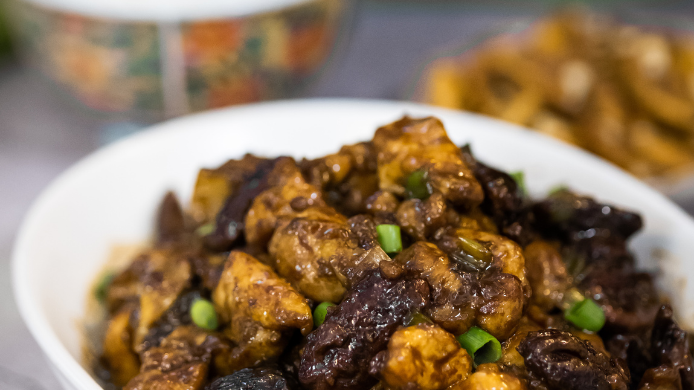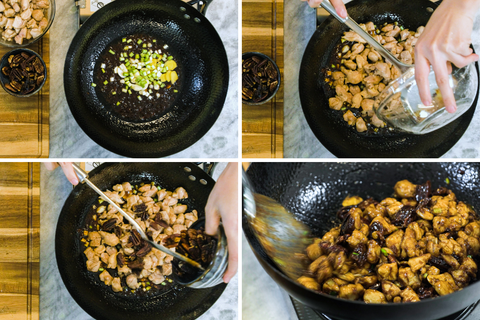Non-spicy Version of “Kung Pao“ Jiang Pao Chicken (酱爆鸡丁)
Rated 3.8 stars by 5 users
Category
Cantonese
Author:

Ingredients
Ingredients for the aromatic water
- 1/4 cup of diced green part of the scallion
- 3 tbsp of diced ginger
- 3 tbsp of Chinese cooking wine
- 1/2 cup of water
Ingredients for marinating the chicken
- 565 grams (20 oz) of chicken cut into bite size
- 2 tbsp of the aromatic water
- 3 tbsp of cornstarch
- 1/3 tsp of salt
Ingredients for the sauce
- 5 tbsp of the aromatic water
- 1/2 tbsp of soy sauce
- 1 tbsp of sweet bean paste
- 2.5 tbsp of soybean paste
- 1 tsp of sugar
Ingredients for stir-frying
- 1/4 cup of diced white part of the scallions
- 3 cloves of garlic thinly sliced
- 1 inche of ginger thinly sliced
- 3/4 cup of pecan or other nuts
- 3 tbsp of oil
Directions
Make aromatic water: in a bowl, add 1/2 cup of water, 1/4 cup of diced green part of the scallion (reserve the white part for later), 2 tbsp of diced ginger, 3 tbsp of Chinese cooking wine. Rub and squeeze the aromatics for a few minutes to release the flavor. Let it go through a sieve.
- Take 3.5 tbsp of the aromatic water. Mix it with 3 tbsp of cornstarch and 1/3 tsp of salt. Save the rest of the aromatic water for later.
- Cut 20oz of chicken thigh into bite-size. Marinade it with the cornstarch mixture. Make sure to massage the chicken for 5 minutes. Let the chicken sit for 20 minutes.
- While waiting, we can make the sauce. In a bowl, mix the following ingredients: 1/2 tbsp of soy sauce, 1 tbsp of Tian Mian Sauce, 2.5 tbsp of soybean paste, 1 tsp of sugar to the rest of the aromatic water. Set it aside.
- Turn the heat to low. Add about 3 tbsp of oil to the wok. Toss in the 3/4 cup of pecans. Stir for a couple of minutes until they become crunchy. Take them out and leave the oil in wok.
- Turn the heat to high and toss in the chicken. Stir for a few minutes or until the chicken halfway cooked. Take the chicken out and set it aside.
- Turn the heat to low. Pour the sauce into the same wok. Stir it on low heat for a few minutes. Add thinly sliced garlic, ginger, and the reserved white part of the scallion. Stir until fragrant.
- Introduce the toasted pecan and the chicken back to the wok. Keep mixing for a couple of minutes until all the chicken is coated with the sauce, and you are done.




































































